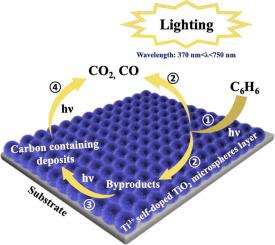Chemical Engineering Journal ( IF 13.3 ) Pub Date : 2020-07-11 , DOI: 10.1016/j.cej.2020.126220 Xin Liu , Ya Zhang , Shigenori Matsushima , Hajime Hojo , Hisahiro Einaga

|
Photocatalytic oxidation processes (PCO processes) are a promising technology for controlling the pollution of working environments, namely, the low concentrations of volatile organic compounds (VOCs) generated in industrial processes, and improving the efficiency of this process is an important issue. In this study, the photocatalytic oxidation of gas-phase benzene was carried out with TiO2 microspheres with a sea-urchin-like structure, and the effect of Ti3+ self-doping on the catalytic performance of TiO2 was investigated in detail. The structures and properties were characterized by X-ray diffraction, X-ray photoelectron spectroscopy, UV–visible diffuse reflectance spectroscopy, electron spin resonance, scanning electron microscopy, and high-resolution transmission electron microscopy. Ti3+ ions were formed in TiO2 microspheres by heating under vacuum, which improved the catalytic performance of TiO2 for the complete oxidation of benzene to CO2 and CO. The photoelectrochemical measurements showed that the incorporation of Ti3+ into TiO2 microspheres reduced electron-hole recombination and increased the light absorption capacity, which contributed to improving the photocatalytic activity. In situ FTIR spectroscopic studies revealed that in the benzene oxidation process, Ti3+ self-doped TiO2 microspheres suppressed the formation of strongly bound byproduct compounds on the TiO2 surface, which affected the rate of benzene oxidation. Thus, the Ti3+ self-doped TiO2 microspheres are effective catalysts for efficient use of UV light and suppression of catalyst deactivation during benzene oxidation.
中文翻译:

具有海胆状结构的Ti 3+自掺杂TiO 2微球的光催化氧化工艺处理气相苯
光催化氧化工艺(PCO工艺)是一种有前途的技术,可用于控制工作环境的污染,即工业工艺中产生的低浓度挥发性有机化合物(VOC),提高此工艺的效率是一个重要的问题。本研究采用海胆状结构的TiO 2微球对气相苯进行光催化氧化,Ti 3+自掺杂对TiO 2催化性能的影响被详细调查。通过X射线衍射,X射线光电子能谱,紫外可见漫反射光谱,电子自旋共振,扫描电子显微镜和高分辨率透射电子显微镜对结构和性能进行了表征。通过真空加热在TiO 2微球中形成Ti 3+离子,这改善了TiO 2对苯完全氧化为CO 2和CO的催化性能。光电化学测量表明Ti 3+掺入TiO 2中微球减少了电子-空穴的重组并增加了光吸收能力,这有助于提高光催化活性。原位FTIR光谱研究表明,在苯氧化过程中,Ti 3+自掺杂TiO 2微球抑制了TiO 2表面上牢固结合的副产物的形成,从而影响了苯的氧化速率。因此,Ti 3+自掺杂的TiO 2微球是有效利用紫外线并抑制苯氧化过程中催化剂失活的有效催化剂。













































 京公网安备 11010802027423号
京公网安备 11010802027423号